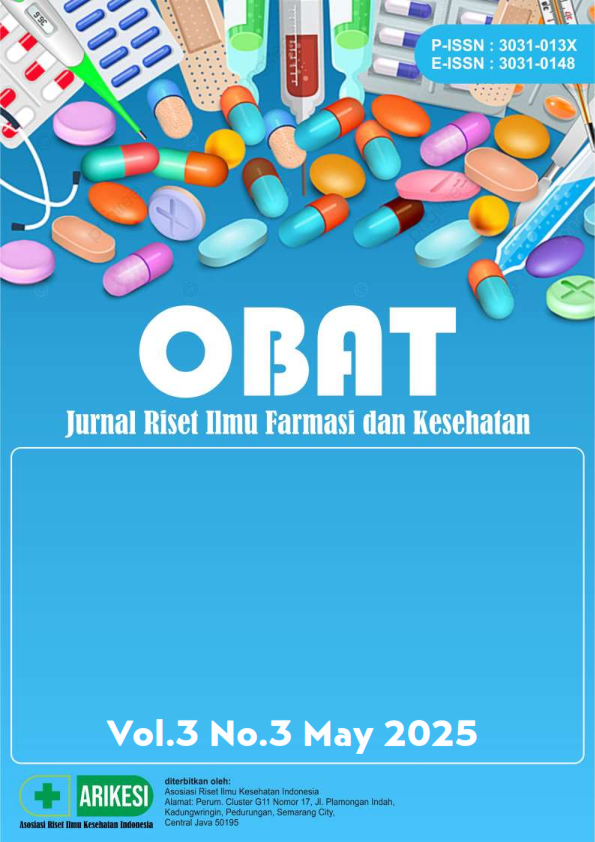Structural and Electronic Effects of Multiligand Coordination in a Single Transition Metal Complex a Study in Organic Reaction Catalysis
DOI:
https://doi.org/10.61132/obat.v3i3.1401Keywords:
Catalytic efficiency, DFT analysis, Hydrogenation, Multiligand coordination, N-heterocyclic Carbenes (NHCs)Abstract
The modulation of the structures and electronic properties of transition metal complexes by multi-ligands coordination has been widely exploited to enhance the catalytic efficiency in organic transformations. Here, we present synthesis, characterization, and catalytic performance of Cu(II), Ni(II) and Pd(II) complexes of multidentate ligands- EDTA, 1,10-phenanthroline and N-heterocyclic carbenes (NHCs). The Pd-NHC complex displayed the high catalytic activity for hydrogenation as well as small-molecule activation, up to 450 h⁻¹ of turnover frequency (TOF) and total conversion of styrene to ethylbenzene at room temperature, and is higher efficient than Cu-EDTA (TOF =120 h⁻¹), Ni-Phen (TOF= 85 h⁻¹). The DFT calculation with Pd-NHC system showed that the small HOMO-LUMO gap (3.2 eV) and the short Pd–C bond (1.95 Å) of Pd-NHC, which could facilitate the transfer of the growth species, contributed to the low energy of activation (28 kJ/mol). Mathematical model also discussed its high catalytic activity (TOF/Ea = 16.07 h⁻¹·kJ⁻¹·mol) due to the strong σ-donor ligands and proper geometry. These findings underscore the influence of ligand architecture to secure transition states and modulate electron density in designing efficient sustainable catalysis that is industrially relevant.
Downloads
References
Broclawik, E., Borowski, T., & Radoń, M. (2019). Transition metals in coordination environments: Computational chemistry and catalysis viewpoints. In Computational chemistry and catalysis viewpoints (pp. 1–22). Springer. https://doi.org/10.1007/978-3-030-11714-6
Choudhary, P., Kumar, S., & Krishnan, V. (2023). Transition metal phosphide nanoarchitectonics for versatile organic catalysis. Small, 19, Article 2207053. https://doi.org/10.1002/smll.202207053
Fan, F., Zhao, L., Zeng, Q., Zhang, L., Zhang, X., Wang, T., & Fu, Y. (2023). Self-catalysis transformation of metal-organic coordination polymers. ACS Applied Materials & Interfaces, 15(31), 36269–36278. https://doi.org/10.1021/acsami.3c07521
Hanyu, H., & Xi, J. (2022). Single-atom catalysis for organic reactions. Chinese Chemical Letters, 34, Article 107959. https://doi.org/10.1016/j.cclet.2022.107959
Hu, S., Huang, J., Gao, M.-L., Lin, Z., Yunyang, Q., Yang, W., Jiao, L., & Jiang, H.-L. (2024). Location-specific microenvironment modulation around single-atom metal sites in metal-organic frameworks for boosting catalysis. Angewandte Chemie International Edition, 64, Article e202415155. https://doi.org/10.1002/anie.202415155
Hu, S., Huang, J., Gao, M.-L., Lin, Z., Yunyang, Q., Yang, W., Jiao, L., & Jiang, H.-L. (2024). Location-specific microenvironment modulation around single-atom metal sites in metal-organic frameworks for boosting catalysis. Angewandte Chemie, 137, Article e202415155. https://doi.org/10.1002/ange.202415155
Juliá, F. (2025). Catalysis in the excited state: Bringing innate transition metal photochemistry into play. ACS Catalysis, 15(8), 4665–4680. https://doi.org/10.1021/acscatal.4c07962
Liang, R.-R., Liu, Z., Han, Z., Yang, Y., Rushlow, J., & Zhou, H.-C. (2024). Anchoring catalytic metal nodes within a single-crystalline pyrazolate metal-organic framework for efficient heterogeneous catalysis. Angewandte Chemie International Edition, 64, Article e202414271. https://doi.org/10.1002/anie.202414271
Liang, R.-R., Liu, Z., Han, Z., Yang, Y., Rushlow, J., & Zhou, H.-C. (2024). Anchoring catalytic metal nodes within a single-crystalline pyrazolate metal-organic framework for efficient heterogeneous catalysis. Angewandte Chemie, 137, Article e202414271. https://doi.org/10.1002/ange.202414271
Raman, R., & Dangi, V. (2024). Exploring the reactivity and stability of transition metal coordination complexes in catalysis. Journal of Advances and Scholarly Researches in Allied Education, 21, Article 24. https://doi.org/10.29070/wzdwjd24
Suremann, N., McCarthy, B., Gschwind, W., Kumar, A., Johnson, B., Hammarström, L., & Ott, S. (2023). Molecular catalysis of energy relevance in metal-organic frameworks: From higher coordination sphere to system effects. Chemical Reviews, 123(2), 1457–1512. https://doi.org/10.1021/acs.chemrev.2c00587
Yong, X., Thurston, R., & Ho, C.-Y. (2019). Electronic effects on chiral NHC–transition-metal catalysis. Synthesis, 51(05), 1021–1033. https://doi.org/10.1055/s-0037-1611751
Zhai, Z., Zhu, J., Cao, S., & Van der Bruggen, B. (2025). Supramolecular engineering of metal-organic membranes with metal-support interactions for nanoconfined synergistic catalysis. Small Methods, 10, Article 202500409. https://doi.org/10.1002/smtd.202500409
Zhang, C.-X., Mei, S., Cao, C., Zhang, W., Xianhe, C., He, T., Feng, Y., Long, G., Tan, G., Zhong, Y.-W., & Yao, C.-J. (2025). Regulating the metal nodes of in situ electropolymerized metal-organic coordination polymers for high performance LIBs. Small, 21, Article 202503163. https://doi.org/10.1002/smll.202503163
Zhang, Z.-F., Zhang, C., & Ye, S. (2024). N-heterocyclic carbene/transition metal dual catalysis. Chemistry – A European Journal, 30(22), e202402259. https://doi.org/10.1002/chem.202402259
Zhao, B., Han, J., Liu, B., Zhang, S., & Guan, B. (2024). Hierarchical metal-organic framework nanoarchitectures for catalysis. Chemical Synthesis, 4, Article 42. https://doi.org/10.20517/cs.2024.42
Downloads
Published
How to Cite
Issue
Section
License
Copyright (c) 2025 OBAT: Jurnal Riset Ilmu Farmasi dan Kesehatan

This work is licensed under a Creative Commons Attribution-ShareAlike 4.0 International License.





